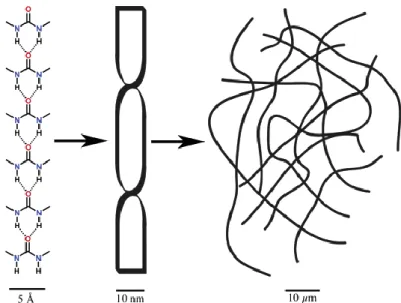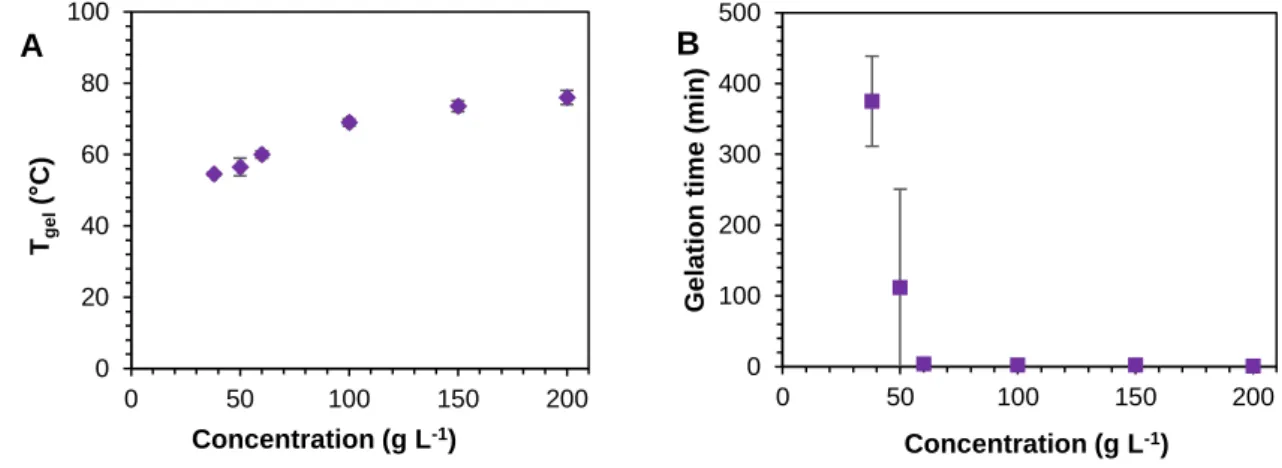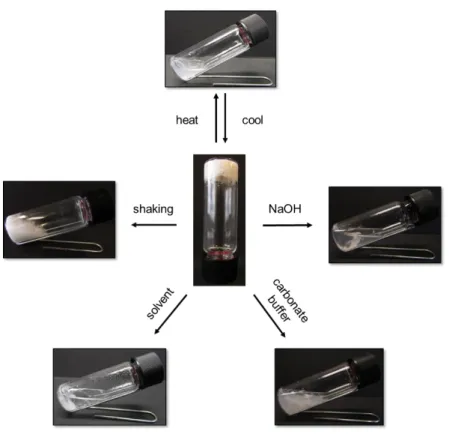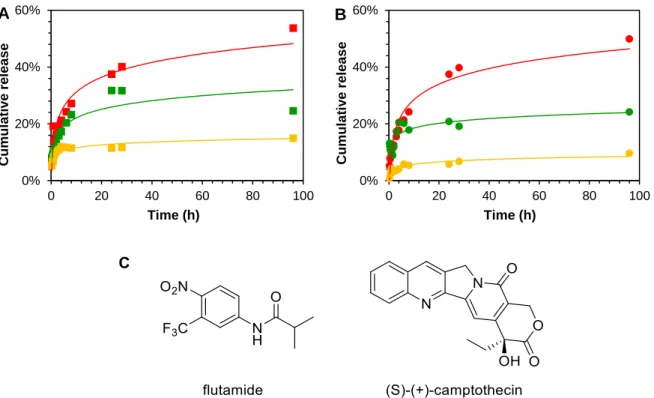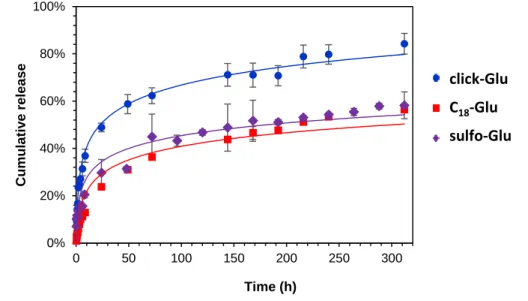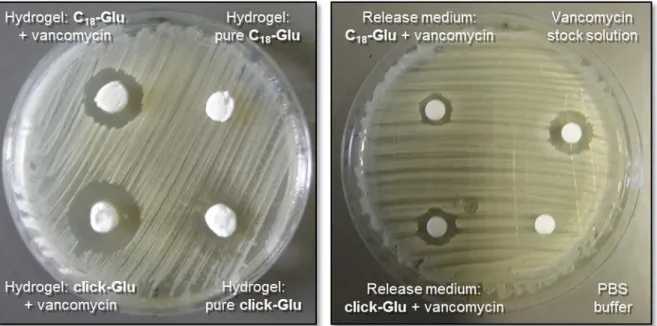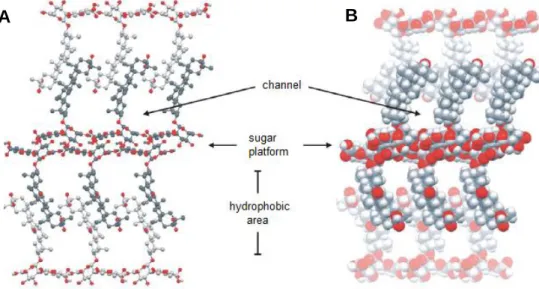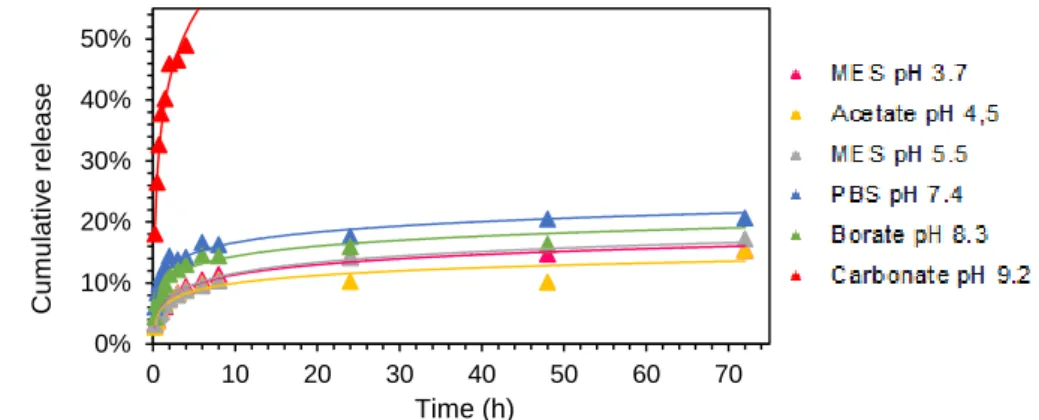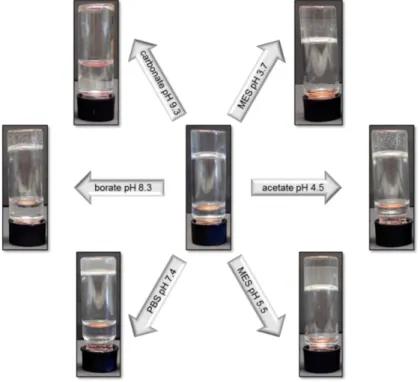Synthesis, characterization and application of smart materials based on low-molecular-weight
compounds and polymers
Dissertation
Zur Erlangung des Doktorgrades Dr. rer. nat.
an der Fakultät für Chemie und Pharmazie der Universität Regensburg
vorgelegt von Judith Mayr
aus Holzhausen am Ammersee
Regensburg 2017
Die Arbeit wurde angeleitet von: Prof. Dr. David Díaz Díaz Promotionsgesuch eingereicht am: 05.05.2017
Promotionskolloquium am: 02.06.2017
Prüfungsausschuss: Vorsitz: Prof. Dr. Joachim Wegener 1. Gutachter: Prof. Dr. David Díaz Díaz 2. Gutachter: Prof. Dr. Ramón Eritja 3. Prüfer: Prof. Dr. Jens Schlossmann
Der experimentelle Teil der vorliegenden Arbeit wurde in der Zeit von Januar 2014 bis Januar 2017 unter der Gesamtleitung von Prof. Dr. David Díaz Díaz am Lehrstuhl für Organische Chemie der Universität Regensburg angefertigt. Zusätzliche Betreuer waren von Juli 2016 bis August 2016 Prof. Jens Schlossmann und von September 2016 bis Oktober 2016 Prof. Ramón Eritja und Dr. Santiago Grijalvo am CSIC-IQAC in Barcelona (Spanien).
Contents
Table of Contents
A Introduction ... 1
1. Gels ... 1
1.1 Supramolecular Gels ... 3
1.2 Application of Gels in Drug Release ... 5
B Gels based low molecular weight compounds ... 6
1.Isosteric replacement for tuning self-assembly and incorporating new functions into soft supramolecular materials ... 6
1.1 Introduction ... 6
1.2 Results and Discussion ... 8
1.2.1 Gelation properties ... 8
1.2.2 Drug release experiments ... 12
1.2.3 Antimicrobial studies ... 15
1.3 Experimental Part ... 17
1.3.1 Synthesis of glutamic acid derived gelators... 17
1.3.2 Gelation time and Tgel vs. concentration ... 20
1.3.3 Stimuli response test ... 21
1.3.4 Drug release ... 21
1.3.5 Antimicrobial studies ... 21
1.4 Conclusions ... 22
2. Release of camptothecin, oxytetracycline and mitoxantrone from glycyrrhizic acid derived water/ethanol gels into several buffered solutions ... 24
2.1 Introduction ... 24
2.2 Results and Discussion ... 25
2.2.1 Drug Release ... 25
2.2.2 Response to buffer solutions ... 29
2.3 Experimental Part ... 30
2.4 Conclusions ... 30
Contents
2.5 Additional Graphics ... 31
3. Improvement of gelation properties of a formamidine based gelator by ultrasonication ... 33
3.1 Introduction ... 33
3.2 Results and discussion ... 34
3.3 Experimental Part ... 39
3.3.1 Synthesis ... 39
3.3.2 Gel-formation ... 41
3.3.3 Temperature controlled NMR ... 42
3.3.4 UV-Vis ... 42
3.3.5 Polarized Light ... 42
3.3.6 PXRD ... 42
3.4 Conclusions ... 42
C Ionenes ... 44
1. Antimicrobial and Hemolytic Studies of a Series of Polycations Bearing Quaternary Ammonium Moieties: Structural and Topological Effects ... 44
1.1 Introduction ... 44
1.2 Results and Discussion ... 45
1.3 Experimental Section ... 49
1.3.1 Materials ... 49
1.3.2 Synthesis of Ionenes ... 50
1.3.3 Antimicrobial assay ... 52
1.3.4 Hemolysis testing ... 52
1.3.5 Contact angle measurements ... 53
1.4 Conclusions ... 53
Contents
2. Transfection of Antisense Oligonucleotides Mediated by Cationic Vesicles Based on Non-Ionic Surfactant and Polycations Bearing Quaternary Ammonium
Moieties ... 54
2.1 Introduction ... 54
2.2 Results and Discussion ... 56
2.2.1 Size and Zeta-Potential Measurements ... 56
2.2.2 SAXS Measurements ... 57
2.2.3 Cytotoxicity Assay ... 59
2.2.4 Transfection ... 60
2.3 Materials and Methods ... 62
2.3.1 Materials ... 62
2.3.2 Preparation of Polyplexes... 63
2.3.3 Zeta-Potential ... 63
2.3.4 Size Measurements ... 64
2.3.5 Small-Angle X-Ray Scattering (SAXS) Measurements of Ionene Polyplexes ... 64
2.3.6 cryo-Scanning Electron Microscopy (cryo-SEM) ... 64
2.3.7 Cytotoxicity Assay ... 65
2.3.8 Gene Transfection and Antisense Technology Studies ... 65
2.4 Conclusions ... 66
3. Aromatic ionene topology and counterion-tuned gelation of acidic aqueous solutions ... 68
3.1 Introduction ... 68
3.2 Results and Discussion ... 70
3.2.1 Gelation properties in aqueous acidic and salt solutions ... 70
3.2.2 Computer Simulations ... 75
3.2.3 HCl gas adsorption ... 76
3.3. Experimental Part ... 77
Contents
3.3.1 Gelation of aqueous acidic solutions ... 77
3.3.2 HCl gas adsorption ... 77
3.4 Conclusions ... 77
D Summary ... 79
E Literature ... 83
F Annexes ... 94
1.Amidine-Glu ... 94
1.1 Aim ... 94
1.2Results ... 94
1.3 Experimental Part ... 95
2. X-bi(phenylalanine-diglycol)-benzene ... 97
2.1 Aim ... 97
2.2 Results ... 97
2.3 Experimental Part ... 98
3. New Ionenes ... 104
3.1 Aim ... 104
3.2 Results ... 104
3.3 Experimental Part ... 105
G NMR Spectra and PXRD ... 108
H List of Abbreviations ... 131
I Curriculum Vitae ... 132
J Acknowledgements ... 136
K Declaration ... 138
Introduction
1
A Introduction
1. Gels
Nature has ever since been an inspiration and many engineers and scientists have tried to mimic numerous of its features. One of these is self-assembly which is found in a variety of natural systems such as proteins,1–3 DNA/RNA,1–4 cell membranes5 and viruses2,3 but also biomineralization in e.g. bones or mollusc shells.6–8 Another example, where the phenomenon of self-assembly occurs is gel formation.
Gels surround us in our daily life as they are used in manifold fields such as agriculture, food and cosmetic industry, pharmaceutical and biomedical applications or electronic devices.9–11
Fig. 1 Variety of application fields of gels.
The term “gel” is not easy to define, as Dorothy Jordon Lloyd recognized in 1926 “the gel, is one which is easier to recognize than to define”.12 Graham coined the term already in 1864 as being materials that seem to constitute an intermediate state between solids and liquids.13 However, over the time many different definitions have been made. One of the most comprehensive definitions was presented by Paul Flory in 1974.14 According to him, a gel 1) has a permanent continuous structure with macroscopic dimensions and 2) in terms of rheology shows a solid like behaviour. In general, gels always consist of at least two parts: a solid phase, which is the gelator and a liquid phase, which is the solvent, where the latter is the major ingredient. The gelator builds up one-dimensional (1D) polymeric structures by either covalent
Introduction
2 (conventional polymers) or non-covalent forces (supramolecular polymers) which then entangle to a three-dimensional (3D) network by physical and/or chemical forces and, in this process, includes the solvent molecules mainly through surface tension and capillary forces (Fig. 2).15–23
Fig. 2 The formation of supramolecular and conventional polymers. Adapted from Ref. 24 with the permission of Royal Society of Chemistry.
For a better understanding of the hierarchical self-assembly process, the polymeric structure of gels can be classified into primary, secondary and tertiary structure (Fig.
3).21 The primary structure (Å – nm) is defined by the recognition of molecules that cause preferably 1D aggregates. The secondary structure (nm - µm) depicts the morphology of these aggregates that can be e.g. micelles, vesicles, fibres, ribbons, or sheets. Finally, the tertiary structure (µm – mm) comprises interaction of individual aggregates and is the final criterion if a stable gel is formed.
Fig. 3 The primary, secondary, and tertiary structure. Reprinted from Ref. 21 with the permission of American Chemical Society
Gels can be classified according to different criteria: 1) medium, 2) source, 3) constitution or 4) crosslinking (see Fig. 4).17 The medium can vary from organic
Introduction
3 solvents (organogels), water (hydrogel), or air (aero- or xerogel). Gelators can derive from both artificial and natural sources which are mostly polymers (e.g. agarose, alginate, chitosan, gelatin, etc.). The constitution describes the nature of the one- dimensional polymers, which can be macromolecular (covalent linked monomers) or supramolecular. Last but not least, gels can be sorted by the type of interaction, which is responsible for the three-dimensional network formation which can be again covalent (chemical) gel or non-covalent (physical gel).
Fig. 4 Classification of gels. Reprinted from Ref. 17 with the permission of Royal Society of Chemistry.
1.1 Supramolecular Gels
The first low-molecular-weight gelator (LMWG) was already discovered in the early 19th century,25 however as the knowledge of aggregation was very poor, it took until the 20th century for these type of gelator to gain more interest of the scientific community.17 In the early times, supramolecular gelators have been found by serendipity, often during a failed crystallization attempt.17 However in the last 20 years, as the knowledge of aggregation increased, researchers became able to design gelators in a rational way, which allows to create material with tailor-made properties. As described above, supramolecular gels base on weak, non-covalent interactions and typically they are prepared by forcing the gelator into solution by heat followed by spontaneous cooling of the isotropic solution to room temperature (Fig. 5).17 But gelation can be also induced by various other stimuli, such as ultrasonication,26,27 building a pH-gradient28,29 or enzymatically.30
Introduction
4
Fig. 5 Formation of a supramolecular gel by heating-cooling process.
During the cooling process, the gelator molecules start to assemble based on forces such as hydrogen-bonding, solvophobic forces, π - π stacking, donor-acceptor interaction, metal-coordination, etc. to 1D strands which entangle themselves to finally build up a 3D network that entrapped the solvent molecules.24,17,22,31–33
In most of the cases, gelators can only form gels in organic solvents or aqueous solutions, although some exceptions exist.34–37 Responsible for this are the different types of interactions that cause the self-assembly. The main driving force for the formation of organogels are dipolar interactions, hydrogen bonding or metal coordination which in sum must overcome the loss of translational and rotational freedom (free energy).20,22,24,38 In contrast to this, hydrogelation is dominated mainly by solvophobic interactions and therefore control over hydrophobic interactions is essential .21,23,39
Within the last three decades, gels based on LMW-compounds (M < 3000 gmol-1) have outnumbered scientific interest of their macromolecular analogues due to a variety of reasons:17,21–23,38,39 a) a huge diversity of gelator-structures is accessible by standard synthetic methods, b) there are many naturally occurring LMWG which have good chances of being biocompatible and biodegradable as their network is solely formed by non-covalent forces, which makes them easier biodegradable than polymeric gel-systems); c) their thermo-reversible property d) very low minimum gelation concentrations are possible and e) their high tolerance towards salts and other additives.17,40 All these features make LMW-compound derived gels very interesting materials as they can react to a variety of external stimuli and can hence be used in a great range of applications.
Introduction
5 1.2 Application of Gels in Drug Release
The number of drugs with a low solubility in water with less than 1 g mL-1 represents a high percentage.41,42 The disadvantages derived from low solubility in water are poor dissolution and membrane permeability, low bioavailability and therefor bad efficiency.41–43 Important for an optimal drug action is the presence at the site of action, a sufficient concentration for a long enough time period.44,45 In order to overcome solubility problems, different strategies have been developed including complexation, solid dispersion, micronization, use of co-solvents, colloidal particulates (e.g. microemulsions, self-emulsifying drug delivery systems, liposomes, niosomes and solid lipid nanoparticles) and nanosizing (nanoemulsions, nanosuspensions, nanoparticles, nanocrystals).41–43,46,47 From administration to the target site drugs may follow a long route on which they can cause severe side effects, especially in case of anti-cancer medicaments.44,45 Therefore parenteral drug delivery systems have been studied extensively over the past few decades. In this field formulations including for example surgical implants,48 PEGylated nanoparticles49 and biodegradable microspheres50 have been developed.
Unfortunately those formulations suffer from several drawbacks. Polymeric implants require a surgical intervention and microspheres are very costly.51 An alternative formulation for a huge field of medicaments are gels which can protect their payload from enzymes or low stomach pH. Gels have been studied already more than a century ago. However, the research interest in this field rocketed around three decades ago.52 More than 95% of publications of the last 60 years were published after 1989.53 The largest part of these dealt with hydrogels derived from cross-linked polymers and there are numerous publications on drug release from gels derived from covalent crosslinking. However these carrier systems comprise several disadvantages including a costly synthesis, the need of non-biocompatible organic solvents, poor mechanics and slow self-healing.51,54 As these gels are formed by a self-assembly process based on non-covalent forces they have several advantages as they are often injectable and can respond to several bio-medically relevant stimuli such as temperature, pH, and the presence of enzymes or ions.55,56
Isosteric replacement for tuning self-assembly and incorporating new functions into soft supramolecular materials
6
B Gels based low molecular weight compounds
1. Isosteric replacement for tuning self-assembly and incorporating new functions into soft supramolecular materials1
1.1 Introduction
Bioisosteric replacement is one of the most important tools in medicinal chemistry for the rational design of new drugs.57,58 The origins of isosterism can be traced back to the early twentieth century to the pioneering work of Langmuir in which he coined this concept to define atoms or molecules which possess the same number and/or arrangement of electrons.59 Thereafter, Grimm’s hydride displacement law60 and Erlenmeyer’s work61 paved the way to the definition of bioisosteres, largely spread by Friedman62 and Thornber63 and later broadened by Burger64 as ‘‘compounds or groups that possess near-equal molecular shapes and volumes, approximately the same distribution of electrons, and which exhibit similar physical properties ...’’.
Nowadays, bioisosteric replacement of amide bonds represents a key strategy in modern research due to its implications in peptide chemistry.65–67 Within this context, many promising approaches introducing acyclic esters, thioamides, ureas, carbamates, oxadiazoles and diazoles have been successfully applied to improve the activity of known drugs or to create new bioactive compounds and materials.58,68 Among these examples, disubstituted 1,2,3-triazoles have been considered as powerful non-classical isosteres of amides as they can mimic either a trans- or a cis- configuration of the amide bond depending on the substitution pattern of the triazole (1,4- or 1,5-, respectively).69,70 Their planar structure exhibits the ability of H-bonding due to the presence of both donor and acceptor groups with similar relative positions.
Although the distance R1-R2 in trans-amides is about 1 Å shorter than that in 1,4-disubstituted triazoles, the overall dipolar moment of the latter (about 5.0 D) is slightly larger than that of secondary amides (about 3.5–4.0 D).
1 Adapted from Ref. 37 with permission from The American Society of Chemistry. Gelation experiments on C18-Glu and click-Glu were performed by J. Bachl. Gelation experiments on sulfo-Glu were performed by J. V. Alegre-Requena apart from stimuli-response tests and Gelation time and Tgel
vs. concentration experiments, which were conducted by J. Mayr. Synthesis was performed by J.
Bachl, J. V. Alegre-Requena and J. Mayr. Drug release and antimicrobial experiments were performed by J. Mayr.
Isosteric replacement for tuning self-assembly and incorporating new functions into soft supramolecular materials
7
Fig. 6 Main structural features of disubstituted trans-amides and 1,2,3-triazoles for their consideration as bioisosteres. Reproduced from Ref. 37 with permission from The Royal Society of Chemistry.
Moreover, the H-bonding abilities (oxygen lone pair electrons = acceptor; N–H amide bond = donor) can be mimicked by the N-2/N-3 lone pairs (acceptor) and the triazole C–H bond (donor) (Fig. 6). Calculations in the gas phase have also suggested that the lone pair on N-3 may be a better H-bond acceptor and metal coordination center than N-2. In addition, the potential β-turn geometry of 1,4-disubstituted triazoles has been supported by computational studies.71 A similar analysis can be done between cis-amides and 1,5-disubstituted 1,2,3-triazoles. Another important isostere of amides is the sulfonamide which is the basis of several groups of drugs. Although there are only very few sulfonamides found in nature,72,73 they are a very popular motif in pharmacy and agriculture.74 Sulfanilamide, the first sulfonamide was synthesized already in 1908 by Gelmo75 followed by the first chemothereutic agent with the brand name Prontosil® which was synthesized in 1934 by Mietzsch and Klarer76 and its antibacterial efficacy was demonstrated 1935 by Domagk.77 Nowadays sulfonamides are not only used as antibiotics but also as diuretics78 and they depict a very important class of antiepileptics.79
Bioisterism proofed to be one of the most important tools in the rational design of new drug molecules but we aimed to use it for the development of new gel materials. N-stearoyl-L-glutamic acid (C18-Glu) is an amphiphilic compound that has been reported to self-assemble into nanofibers in chloroform and nanodisc-like structures in 1 : 1 mixed EtOH– water.36 We envisioned that this molecule could also undergo self-assembly in many other solvents at suitable concentrations. In addition, it provided us with a unique opportunity to assess the transplantation of the isosteric replacement paradigm from medicinal chemistry to soft materials.
Isosteric replacement for tuning self-assembly and incorporating new functions into soft supramolecular materials
8 1.2 Results and Discussion
1.2.1 Gelation properties
Our group presented in 2014 the replacement of the amide moiety in C18-Glu by a 1,4-disubstituted 1,2,3-triazole unit, in which the total number of C atoms has formally been kept intact. This new compound, click-Glu, was readily synthesized by the copper(I)-catalysed azide–alkyne cycloaddition, also known as click reaction.80
Fig. 7 Gelators C18-Glu and click-Glu derived from L-glutamic.
The gelation ability of C18-Glu and click-Glu was systematically investigated by applying a heating–cooling cycle in water and several organic solvents (including non-polar, polar protic and polar aprotic solvents). Materials that did not exhibit gravitational flow upon turning the vial upside-down were preliminary classified as stable gels. No visible changes were observed in model examples upon one year of aging, and their gel nature was further confirmed by dynamic rheological measurements. Eleven different gels could be obtained with both gelators in oxygenated, hydrocarbon (including aromatic and aliphatic) and halogenated solvents. Despite the fact that many solvents could be gelled by either C18-Glu or click-Glu, the critical gelation concentration (CGC), thermal stability and gelation kinetics were different in each case. Click-Glu generally exhibited about 25–55%
lower CGC values than C18-Glu when polar protic and polar aprotic solvents were used (e.g., water, MeOH, glycerol, and MeCN). On the other hand, an opposite behavior (around 10–75% higher CGC) was usually observed in non-polar solvents (e.g., Et2O, DCM, n-hexane, and toluene). Although most gels were obtained within minutes regardless of the gelator structure, the gelation kinetics was found to be significantly slower in polar solvents. Independent of the nature of the solvent or the gelator, all gels exhibited full thermo-reversibility with gel-to-sol transition temperatures (Tgel) in the range of about 40–70 °C as indicated by DSC among other techniques. Remarkably, some Tgel values exceeded the boiling points of the corresponding solvents. Similar to the trends observed for CGC-values, materials
Isosteric replacement for tuning self-assembly and incorporating new functions into soft supramolecular materials
9 derived from click-Glu generally exhibited, at comparable concentrations, higher Tgel
values in polar solvents than those obtained from C18-Glu, which were superior in non-polar solvents.
Electron microscopy imaging was used in order to gain visual insight into the morphologies of model gels prepared in water and CHCl3, respectively.
Fig. 8 FESEM images of xerogels A) C18-Glu in water (25 g L-1); B) C18-Glu in CHCl3 (100 g L-1); C) click- Glu in water (25 g L-1); D) click-Glu in CHCl3 (100 g L-1).
In good agreement with previous observations,36 FESEM images of the xerogels based on C18-Glu in a polar-protic environment revealed the formation of nano- almond-like structures, whereas layered lamellar assemblies were observed in CHCl3. A practically opposite behavior was observed for materials based on the isosteric click-Glu. Thus, wrinkled lamellar structures were observed in water, whereas almond crunch-like structures were revealed in CHCl3. In general, dense fibrillar networks of high aspect ratios were also observed by TEM imaging. When click-Glu was used as the gelator, the density of the fibrillary bundles was much higher than observed in the case of C18-Glu.
As the isosteric replacement of the amide function in N-stearoyl L-glutamic acid by a 1,4-disubstituted 1,2,3-triazole could be successfully transmitted to the tuning of soft materials, we decided to investigate another isostere of an amide function which is the sulfonamide. This sulfo-Glu gelator was synthesized via substitution of 1-octadecyne sulfonyl chloride by a double tert-butyl protected L-glutamic acid and subsequent deprotection. The new compound was tested for its gelation ability of the same solvents as described above.
Isosteric replacement for tuning self-assembly and incorporating new functions into soft supramolecular materials
10
Fig. 9 Structure of sulfonamide based gelator sulfo-Glu derived from isosteric replacement.
In general sulfo-Glu was found to show lower CGCs than the other two gelators in non-polar halogenated and aromatic solvents (e.g. DCM, CHCl3, xylene, benzene, and toluene) as well as in the polar, aprotic solvents glycerol and MeCN. In contrast to click-Glu and C18-Glu, it was able to gel AcOEt, chlorobenzene and benzonitrile.
However, sulfo-Glu revealed the highest CGC for water and polar protic solvents such as MeOH, EtOH, iPrOH. Additionally DMSO, Et2O and n-hexane could not be gelled in contrast to click-Glu and C18-Glu which could gel these solvents.
In the following the influence of gelator concentration on Tgel and gelation time was investigated for gels in water and CHCl3 derived from C18-Glu and click-Glu (see Ref. 37 Fig S9) as well for hydrogels derived from sulfo-Glu (Fig. 10). As expected, Tgel increased with the increasing gelator concentration regardless of the solvent or the gelator, which is in agreement with the gradual formation of denser packed supramolecular networks.
Fig. 10 A) Evolution of Tgel with increasing gelator concentration. B) Gelation kinetics of sulfo-Glu.
For each gelator obvious plateau regions were reached at around 100 g L-1 indicating the thermal stability cannot be increased infinitely. The time necessary to form stable gels drops extremely with increasing concentration which again indicates a denser packaging.
0 20 40 60 80 100
0 50 100 150 200
Tgel(°C)
Concentration (g L-1)
0 100 200 300 400 500
0 50 100 150 200
Gelation time (min)
Concentration (g L-1)
A B
Isosteric replacement for tuning self-assembly and incorporating new functions into soft supramolecular materials
11 Additionally the stimuli response behavior of gels derived from C18-Glu, click-Glu and sulfo-Glu was investigated.
Fig. 11 Multistimuli response of a gel derived from sulfo-Glu in water (38 g L-1).
Generally all gel-materials showed full thermo-reversible behaviour, regardless of gelator and nature of the solvent, without any remarkable changes in Tgel-values even after several cycles of heating and cooling. Irreversible gel-to-sol phase transitions could be observed by mechanical agitation and addition of certain chemical substances. Gel-materials were dissolved in the presence of NaOH and basic buffered solutions (borate buffer pH = 9.2) while being stable towards neutral and acidic conditions. Only click-Glu dissolved slowly upon addition of phosphate buffer saline (PBS; pH = 7.4) were C18-Glu and sulfo-Glu remained stable. Treat- ment with several organic solvents led to multifacted results. While C18-Glu and click-Glu were stable against addition of most organic solvents, sulfo-Glu underwent phase transition in the presence of EtOAc and n-hexane. Response towards other organic solvents (i.e. MeOH, acetone and DCM), as well as to metal- ions (i.e., Ag+, Cu2+ and Fe3+), halides (TBAF), could not be observed regardless of the gelator. In general the response towards external stimuli was quite fast being in a range between 30−240 min resulting in complete dissolution or collapse of the gel phases.
Isosteric replacement for tuning self-assembly and incorporating new functions into soft supramolecular materials
12 1.2.2 Drug release experiments
Hydrogels prepared from C18-Glu and click-Glu were for the first time evaluated as carriers for tuning the kinetics of drug release. Vancomycin, a useful glycopeptidic antibiotic for the treatment of infections mostly caused by Gram-positive bacteria, was selected in the first instance as hydrophilic model drug.81 Stable hydrogels towards a PBS buffer could be obtained using a gelator concentration of 60 g L-1.
Fig. 12 Left: Release profile of vancomycin in PBS from hydrogels based on click-Glu, C18-Glu and co- assembled click-Glu:C18-Glu (9:1, w/w). Right: Chemical structure of vancomycin.
Thus, we used these conditions for preliminary studies of the release kinetics of entrapped vancomycin (initial drug concentration in the gel phase = 1.38 x 10-3 M).
Up to 90% drug release was observed within 13 days in the case of click-Glu, whereas C18-Glu showed much slower kinetics (around 56% within the same period).
In general, release kinetics obeyed a first-order integrated rate law reasonably well (kobs [C18-Glu] = 1.5 ± 0.2 x 10-2 h-1; kobs [click-Glu] = 4.3 ± 0.3 x 10-2 h-1). These results can be associated with different diffusion properties of the drug through hydrogels with diverse nano-morphologies, which are ultimately governed by the isosteric gelator structure (obviously, the interaction patterns between solvent–
gelator, gelator–gelator and gelator/fibril-drug molecules play a key role in such a complex scenario). As expected, a faster release rate was also observed upon decreasing the gelator concentration due to the decrease of the crosslink density of the network (Fig. 13A) Remarkably, the complementary structure of the isosteric gelators allowed the preparation of stable hydrogels via co-assembly of both gelators
0%
20%
40%
60%
80%
0 50 100 150
Cumulative release
Time (h)
click-Glu:C18-Glu (9:1)
click-Glu
C18-Glu
Isosteric replacement for tuning self-assembly and incorporating new functions into soft supramolecular materials
13 at different ratios, offering an alternative tuning option for fine-tuning the drug release (Fig. 12).
Fig. 13 A) Effect of the gelator concentration on the release of vancomycin from hydrogels made of click- Glu and C18-Glu. B) Release of vancomycin from a hydrogel prepared using click-Glu:C18-Glu (1:1, w/w).
However, the change in the kinetics upon co-assembly was not proportional to the molar ratio of the gelator (Fig. 13B) suggesting the formation of complex interpene- trated networks and release kinetics.
Not only vancomycin was used as model drug in this study. Also, the release of methotrexate hydrate, which is a non-water-soluble anti-cancer agent, was investi- gated (initial drug concentration in the gel phase = 0.66 x 10-3 M). Gels were prepared for this purpose in a stock solution of methotrexate in water/EtOH 1:1 mixture with C18-Glu and click-Glu. In this case, a gelator concentration of 50 g L-1 was sufficient to form stable gels in contrast to 60 g L-1 for vancomycin release, which is eventually due to the presence of EtOH. However, this is surprisingly, since C18- Glu did not show the ability to gel pure EtOH. The stability of gels derived from both gelators towards addition of PBS turned out to be similar which is in good agreement with the great similarity in the release profiles (kobs [C18-Glu] = 2.9 x 10-2 h-1; kobs
[click-Glu] = 3.3 x 10-2 h-1) of methotrexate from C18-Glu and click-Glu derived gels (Fig. 14). Also in the water /EtOH 1:1 mixture a co-assembly of both gelators at different ratio was possible. However, again the change in the kinetics upon co- assembly was not proportional to the molar ratio of the gelator.
0%
20%
40%
60%
80%
100%
0 10 20
Cumulative release
Time (h)
A click-Glu 50 mg
click-Glu 60 mg
C18-Glu 50 mg C18-Glu 60 mg
0%
20%
40%
60%
80%
100%
0 100 200 300
Cumulative release
Time (h)
B
Isosteric replacement for tuning self-assembly and incorporating new functions into soft supramolecular materials
14
Fig. 14 Left: Release profile of methotrexate· water in PBS from hydrogels based on click-Glu, C18-Glu and co-assemblies of both gelators at different click-Glu:C18-Glu (w/w) ratios. Right: Chemical structure of methotrexate·H2O.
In order to compare the influence of drug hydrophilicity on their release rate, preliminary release tests with flutamide and campthotecin, which are anti-cancer agents, as well were performed (Fig. 15A and B). The three anti-cancer drugs exhibit a molecular weight in the same range but differ in their hydrophilicity (flutamide: logP
= 3.35 82, camptothecin: logP = 1.74 83, methotrexate: logP = -1.85 83) were methotrexate inherits the greatest hydrophilicity and flutamide the greatest hydrophobicity.
Fig. 15 Release profile of methotrexate·H2O (■,●), camptothecin (■,●) and flutamide (■,●) in PBS from hydrogels based on A) C18-Glu and B) click-Glu. C) Chemical structures of flutamide and camptothecin.
0%
20%
40%
60%
80%
0 10 20 30 40 50
Cumulative release
Time (h)
click-Glu 1 : 0.3 1 : 1 1 : 2 0.3 : 1 C18-Glu
0%
20%
40%
60%
0 20 40 60 80 100
Cumulative release
Time (h)
A
0%
20%
40%
60%
0 20 40 60 80 100
Cumulative release
Time (h)
B
Isosteric replacement for tuning self-assembly and incorporating new functions into soft supramolecular materials
15 A clear relation between hydrophilicity and diffusion of the drugs into the surrounding release medium was found. This can be explained by the environmental conditions in the gel, which are more hydrophobic in comparison to the release buffer. Therefore, hydrophobic molecules tend to be more retained in the gel medium which comprises the favorable environment. More hydrophilic molecules experience a higher repulsion by the gel fibers and a higher attraction by the release medium which leads to a faster diffusion into the release medium.
Finally, also a hydrogel derived from sulfo-Glu was used as a drug carrier for vancomycin. Again the drug release followed a first-order integrated rate law (kobs
[sulfo-Glu] = 1.3 ± 0.1 x 10-2 h-1). Within 13 days around 58% of the initial drug amount was released into the surrounding medium whereat the release profile showed a remarkable similarity to that from C18-Glu derived hydrogel (kobs [C18-Glu]
= 1.5 ± 0.2x 10-2 h-1; 56% release in 13 days).
Fig. 16 Release profile of vancomycin in a PBS buffer from hydrogels based on click-Glu, C18-Glu and sulfo-Glu.
1.2.3 Antimicrobial studies
The antimicrobial activities of the hydrogels with and without vancomycin against the Gram-positive bacteria Staphylococcus aureus were evaluated using the Kirby–
Bauer test (Fig. 17, left).
0%
20%
40%
60%
80%
100%
0 50 100 150 200 250 300
Cumulative release
Time (h)
click-Glu C18-Glu sulfo-Glu
Isosteric replacement for tuning self-assembly and incorporating new functions into soft supramolecular materials
16
Fig. 17 The zone of inhibition test against Staphylococcus aureus. Left) for vancomycin containing hydrogels derived from C18-Glu and click-Glu and their corresponding controls right) for release medium (on filter paper)after 24 h of vancomycin release from hydrogels.
Large inhibition zones (21.5 mm and 18 mm for drug loaded click-Glu and C18-Glu, respectively) were observed. The results were in good agreement with the faster release kinetics of click-Glu hydrogels vs. C18-Glu. No inhibition zones were evident with control gel samples. Maintenance of antimicrobial activity of the released drug was also confirmed (Fig. 17, right).
Fig. 18 The zone of inhibition test against Staphylococcus aureus Left) for vancomycin containing hydrogels derived from sulfo-Glu and their corresponding controls right) for release medium (on filter paper) after 24 h of vancomycin release from hydrogels.
Isosteric replacement for tuning self-assembly and incorporating new functions into soft supramolecular materials
17 Also sulfo-Glu derived hydrogels were tested in the Kirby-Bauer test (Fig. 18). Large inhibition zones (Ø = 22.5 ± 0.5 mm) were formed around the hydrogel samples containing the drug, whereas the bacteria grew almost to the edge of the pure hydrogels. Even though the conditions for the zone of inhibition test were the same as for click-Glu and C18-Glu the sizes of the inhibition zones cannot be compared since the test was not performed on the same agar plate. Testing the buffer medium of the drug release experiment after 24 h showed that the antimicrobial activity maintained (zone Ø = 14.5 ± 0.5 mm). A positive control (aq. vancomycin solution 2 g L-1, zone Ø = 20 mm) and a negative control (pure PBS buffer) illustrates, in good agreement with the drug release experiment, that within the first 24 h only parts of the drug diffused from the gel.
1.3 Experimental Part
1.3.1 Synthesis of glutamic acid derived gelators Synthesis of N-stearoyl-L-glutamic acid C18-Glu
To a stirred solution of L-glutamic acid diethyl ester hydrochloride (1.72 g, 7.2 mmol) and NEt3 (3.0 mL, 21.5 mmol) in dry methylene chloride (150 mL) at 0 °C, a solution of stearoyl chloride (2.47 g, 8.2 mmol) in dry methylene chloride (20 mL) was added slowly over a period of 1h. The mixture was allowed to warm to RT and stirred for additional 3 h, after which time water (50 mL) was added. The organic layer was separated, washed with water (4 × 50 mL), dried over Na2SO4, filtered and the solvent was removed under reduced pressure. The obtained residue was dissolved in a 1:1 mixture of MeOH/water (150 mL) and KOH (1.18 g, 21.6 mmol) was added. The obtained suspension was stirred at RT for 18 h. MeOH was removed under reduced pressure and the aqueous phase was acidified with 2 M HCl to pH = 2. The formed precipitate was filtered off, thoroughly washed with water, dried and recrystallized from acetone affording the title compound as white solid.
Yield: 1.23 g (36%); C23H43NO5 (413.60);
Isosteric replacement for tuning self-assembly and incorporating new functions into soft supramolecular materials
18
1H NMR (300 MHz, DMSO-d6) δ (ppm) 8.03 (d, 1H), 4.21–4.14 (m, 1H), 2.26 (t, 2H), 2.09 (t, 2H), 2.00–1.88 (m, 1H), 1.80–1.67 (m, 1H), 1.49–1.41 (m, 2H), 1.23 (s, 28H), 0.85 (t, 3H)
Synthesis of 1H-imidazole-1-sulfonyl azide
Sodium azide (7.5 g, 115 mmol) was suspended in dry MeCN (100 mL) followed by cooling this mixture to 0 °C, then thionyl chloride (8.1 mL, 100 mmol) was added dropwise over a period of 30 min. After stirring at room temperature for 20 h imidazole (13.0 g, 190 mmol) was added in portions and the slurry was stirred at room temperature for further 3 h. Subsequently EtOAc (200 mL) was added and the mixture was washed with water (3 x 100 mL) and sat. NaHCO3 (3 x 100 mL). The organic layer was dried over Na2SO4, filtered and cooled to 0 °C. To this solution acetyl chloride (10.7 mL, 150 mmol) was added dropwise over a period of 30 min.
The slurry was allowed to chill at 0 °C for 1.5 h while precipitation occurred which was then filtered and washed with ice cold EtOAc (25 mL) and dried in vacuum to give the product as pure white crystalline solid.
Yield: 11.0 g (52%), C3H3N5O2S·HCl (209.61 g mol-1)
1H NMR (300 MHz, D2O) δ (ppm) 9.24 – 9.19 (m, 1H); 7.87 – 7.86 (m, 1H); 7.46 – 7.44 (m, 1H)
Synthesis of (S)-2-azidopentanedioic acid
1H-Imidazole-1-sulfonyl azide hydrochloride (6.23 g, 36 mmol), was added to a suspension of L-glutamic acid (4.41 g, 30 mmol), anhydrous potassium carbonate (15.34 g, 111 mmol) and copper(II) sulfate pentahydrate (75 mg, 0.30 mmol) in methanol (75 mL). The reaction mixture was stirred overnight at room temperature.
Then, the solvent was removed and the resulting residue was diluted with water
Isosteric replacement for tuning self-assembly and incorporating new functions into soft supramolecular materials
19 (40 mL), acidified with conc. HCl to give pH 2 and extracted with EtOAc (3 × 100 mL).
The combined organic layers were dried over Na2SO4, filtered and concentrated. The resulting residue was purified by column chromatography (eluent: EtOAc) affording the desired product as colourless oil.
C5H7N3O4 (173.13 g mol-1)
For safety reasons the solvent was not evaporated completely so no yield was determined.
1H NMR (300 MHz, DMSO-d6) δ (ppm) 12.75 (brs, 2H), 4.11 (dd, 1H), 2.39–2.22 (m, 2H), 2.05–1.98 (m, 1H), 1.88–1.73 (m, 1H)
Synthesis of (S)-2-(5-hexadecyl-1H-1,2,3-triazol-1-yl)pentanedioic acid click-Glu
To a stirred solution of octadec-1-yne (1.20 g, 4.80 mmol) and (S)-2-azidopen- tanedioic acid (1.25 g, 4.80 mmol) in a 1:2 (v/v) mixture of DMSO/ water (5 mL) at RT CuSO4⋅5H2O (120 mg, 0.48 mmol) and sodium ascorbate (380 mg, 1.92 mmol) were added. Due to a clear increase of viscosity after a short period of time, the total solvent volume was further increased to 10 mL. After stirring for 72 h, the solvent mixture was removed by lyophilization. The obtained residue was redissolved in a 1:1 (v/v) mixture of EtOAc/THF (50 mL) and washed with brine containing 0.1 M EDTA⋅Na2 (2 × 50 mL), brine (2 × 25 mL) and water (3 × 25 mL) in order to remove most of organic and inorganic impurities. The organic layer was dried over Na2SO4, filtered and concentrated under reduced pressure. The obtained residue was recrystallized from acetone affording the title compound as a white solid.
Yield: 1.01 g (50%), C23H41N3O4 (423.60g mol-1)
1H NMR (300 MHz, DMSO-d6) δ (ppm) 7.95 (s, 1H), 5.35 (dd, 1H), 2.60 (t, 2H), 2.46–
2.37 (m, 1H), 2.35–2.22 (m, 1H), 2.17–1.96 (m, 2H), 1.58 (t, 2H), 1.23 (s, 26H), 0.85 (t, 3H)
Isosteric replacement for tuning self-assembly and incorporating new functions into soft supramolecular materials
20 Synthesis of (octadecylsulfonyl)-L-glutamic acid sulfo-Glu
1-octadecyne sulfonyl chloride (1.44 g, 4.1 mmol) was dissolved in dry DCM (40 mL) under N2-atmosphere at 0 °C. NEt3 (1.71 mL, 12.3 mmol) and L-Glutamic acid di-tert- butyl ester·HCl (1.21 g, 4.1 mmol) were added. The reaction mixture was stirred at 0 °C for 1 h and subsequently for 3 days at room temperature. The solvent was evaporated and the resulting residue was purified by column chromatography (eluent hexanes/EtOAc 5:1 to 1:5). The intermediate was redissolved in DCM (18 mL) and TFA (3 mL) and was stirred at room temperature for 18 h. The solvent was evaporated and crude product was washed with ice cold DCM (20 mL) to give the desired product as a white solid.
Yield: 1.06 g (56%); C23H45NO6S (463.67);
1H NMR (300 MHz, DMSO-d6) δ (ppm) 7.57 (m, 1H); 3.83 (m, 1H); 2.94 (m, 2H); 2.33 (m, 2H); 1.92 (m, 1H); 1.67 (m, 3H); 1.23 (s, 30H); 0.85 (t, 3H)
1.3.2 Gelation time and Tgel vs. concentration
Gelator and milli-Q water (500 µL) were placed in screw capped vials (final concentrations 38, 50, 60, 100, 150 and 200 g L-1). The samples were heated until turbid solutions were formed. The time that was necessary for gel formation was measured by turning the vials upside down and the point where no flow occurred was considered as being the gelation time. After resting for 19 h, the samples were heated in a custom-made heating block at a rate of about 2 °C / 5 min. Melting points were measured by inverse flow method.
Isosteric replacement for tuning self-assembly and incorporating new functions into soft supramolecular materials
21 1.3.3 Stimuli response test
A weighted amount of the corresponding gelator and milli-Q water (500 µL) were placed in a screw capped vial (final concentrations: C18-Glu 25 g L-1, click-Glu 17 g L-1 and sulfo-Glu 38 g L-1, respectively). The samples were tempered in a custom made heating block at 100 °C for 1 h whereat homogeneous, turbid solutions were formed. Subsequently the samples were allowed to cool slowly to room temperature. After 19 h stable gels were obtained which were overlaid with each 500 µl of different solvents or solutions (0.1 M). The samples were stored at room temperature and observed for 24 h.
1.3.4 Drug release
A weighted amount of the corresponding gelator (50 – 60 mg), and 1 mL of a drug stock solution (vancomycin: 2 g L-1 in water, methotrexate hydrate: 0.3 g L-1 in water/EtOH 1:1; camptothecin: 0.1 g L-1 in water/EtOH 9:1; flutamide: 0.8 g L-1 in water/EtOH 9:1) were placed in a screw-capped glass vial and gently heated until all solid materials were completely dissolved. The obtained isotropic solution was allowed to cool down to RT resulting in gel formation with a physically incorporated drug.
Obtained gel materials were overlaid with phosphate buffered saline (PBS, 1 mL, pH = 7.4) 16 h after their formation, which was considered as the starting point for the experiments. At selected points of time aliquots (100 μL) were removed and diluted with PBS to 1 mL. Then fresh PBS (100 μL) was added over the gel to maintain infinite sink conditions. Drug concentration in the aliquots was determined during the experiments using UV-spectroscopy after proper calibration using the maximum absorbance of drugs in aqueous media (vancomycin: 280 nm; methotrexate hydrate 303 nm; camptothecin: 371 nm; flutamide: 303 nm). Samples were centrifuged (EBA 12 Hettich Zentrifugen) at 4000 rpm for 5 min before measurements. It was verified that degraded gel materials exhibited a minimum absorbance in the region of drug detection.
1.3.5 Antimicrobial studies
The Zone of Inhibition Test, also called Kirby-Bauer Test, is used clinically to qualitatively measure antibiotic resistance and industrially to test the ability of specimens to inhibit microbial growth.
Isosteric replacement for tuning self-assembly and incorporating new functions into soft supramolecular materials
22 Preparation of agar plates: A solution of 1% peptone, 0.5% yeast, 0.2% glucose and 1.5% of agar-agar (w/v) in milli-Q water was autoclaved at 120 °C for 20 min and then shaken. After cooling down to 95 °C, a Petri dish (8.5 cm diameter) was filled to half of the volume (about 25 mL). The dishes were shaken circularly on the bench to bring air bubbles to the edge. After cooling to room temperature, the plates were placed upside down to avoid condensed water to drop on the medium and stored in the refrigerator at 2-8 °C.
Hydrogels preparation: An aqueous vancomycin solution (1 mL from a 2 M solution) was added to a screw-capped vial containing either C18-Glu, click-Glu or sulfo-Glu (60 mg). The mixture was heated until complete dissolution of the material, transferred to a 2 mL syringe with cut cap and rested over night to obtain the corresponding stable hydrogels.
Antimicrobial tests with hydrogel pieces: S. aureus was seeded out evenly with a cotton bud on agar medium. Cylindrical gel pieces of approximately 4 mm length and 9 mm diameter (0.25 mL) were placed on the bacteria plates. The plates were stored at 37 °C for 17 h.
Release of vancomycin from the hydrogels: An aqueous vancomycin solution (1 mL from a 2 M solution) was added to a screw-capped vial containing either C18-Glu, click-Glu or sulfo-Glu (60 mg). The mixture was heated until complete dissolution of the material and rested over night to obtain the corresponding hydrogels. The loaded-hydrogels were overlaid with PBS buffer (1 mL) and rested for additional 24 h.
Antimicrobial tests with drug release supernatants: S. aureus was seeded out evenly with a cotton bud on agar medium. Three samples of filter papers were soaked separately in 20 μL of (a) supernatant obtained from the drug release experiment, (b) pure PBS and (c) aqueous vancomycin solution (2 M). The specimens were placed on the plates and stored at 37 °C for 17 h.
1.4 Conclusions
In conclusion, the isosteric replacement paradigm from medicinal chemistry can be successfully applied to the synthesis of novel soft functional materials. As a proof-of- concept, isosteric gelators C18-Glu, click-Glu and sulfo-Glu afforded the preparation of a variety of physical hydrogels and organogels with different thermal, mechanical, morphological and diffusional properties. In general, click-Glu revealed superior features with respect to the CGC, Tgel and mechanical stabilities in polar protic solvents, whereas sulfo-Glu exhibited improved properties in non-polar solvents and
Isosteric replacement for tuning self-assembly and incorporating new functions into soft supramolecular materials
23 C18-Glu showed in average values between those of click-Glu and sulfo-Glu.
Additionally the three isosteres proofed to be applicable for the in vitro delivery of drugs with different sizes and hydrophilicities. A sustained release over several days up to two weeks could be achieved, where diffusion from click-Glu derived hydrogels was faster than from C18-Glu and sulfo-Glu, which exhibited similar release profiles.
Moreover, the co-assembly of C18-Glu and click-Glu was successfully applied for fine-tuning the release of the antibiotic vancomycin and the anti-cancer agent methotrexate. The antibiotic activity of vancomycin loaded hydrogels against the Gram-positive Staphylococcus aureus, as well as maintenance of efficacy of the released drug was also confirmed. Overall, these results open up many exciting opportunities for the development of new functional materials with unique properties for different applications beyond the field of gels.
Release of camptothecin, oxytetracycline and mitoxantrone from glycyrrhizic acid derived water/ethanol gels into several buffered solutions
24 2. Release of camptothecin, oxytetracycline and mitoxantrone from glycyrrhizic
acid derived water/ethanol gels into several buffered solutions 2.1 Introduction
Glycyrrhizic acid (GA) or glycyrrhizin is a natural occurring saponin, which can be extracted from the licorice (liquorice) root (Glycyrrhiza glabra) in the form of its potassium, calcium and magnesium salts. It is the ingredient which is mainly responsible for the sweet taste of this root. The chemical structure consists of a lipophilic pentacyclic triterpenoid and a hydrophilic part which are two β (1→2) linked glucuronic acid units (Fig. 19) Due to this amphiphilic structure it is able to form micelles in water and water/alcoholic solutions. Its ability to form stable hydrogels was already described in 1879 by Habermann.84
Fig. 19 Structure of Glycyrrhizic acid
X-ray crystallography has shown that GA can self-assemble into a supramolecular interdigitated network, with alternating hydrophilic and hydrophobic areas.85,86 The diglucuronic acid units build up hydrophilic platforms via H-bonding (Fig. 20) while the hydrophobic areas, deriving from terpenoid structures, exhibit channels which can be filled with solvent or guest molecules. Remarkably chemical differences between GA and its mono- and dibasic salts practically have no impact on the supramolecular organization. This isomorphism is due to a specific structure of hydrophilic bilayers assembled from zigzag chains of neutral, mono-anionic, or di-anionic diglucuronic acid units. Counter ions like ammonium, potassium, or cesium were found to be able to replace hydrogen-bonded water molecules in the hydrophilic sugar platform.
Release of camptothecin, oxytetracycline and mitoxantrone from glycyrrhizic acid derived water/ethanol gels into several buffered solutions
25
Fig. 20 Self-assembly of glycyrrhizic acid. A) Ball and stick and B) space filling representation. Reprinted from Ref. 86 with permission from American Chemical Society.
The applications of GA are manifold, e.g. as emulsifier and sweetener in food industry. Apart from that, the Glycyrrhiza glabra has been used as medical plant for more than 100 years. Glycyrrhizic acid has many pharmaceutical application it has been found to have anti-hepatotoxic,87,88 anti-ulcerogenic,89 anti-allergenic90 and anti- inflammatory activities91 as well as inhibitory activities in the replication of several DNA and RNA viruses in vitro.92 Indeed GA has been also used as an adjuvant for drug delivery due to its ability to solubilize poorly water soluble drugs which was first described in 1963.93 The first time glycyrrhizin was used as a drug carrier itself, was presented by Segal et. al in 1986, where the authors entrapped several bioactive compounds in hydrogels derived from GA for the treatment of mucosal lesions due to herpes.94
2.2 Results and Discussion 2.2.1 Drug Release
Glycyrrhizic acid ammonium salt is also a good hydrogelator with excellent biocom- patibility whose hydrogels additionally are able to tolerate up to 25 wt% ethanol.
Therefore, it is an interesting candidate for the physical entrapment and subsequent release of hydrophilic as well as hydrophobic drug molecules. For the purpose of studying the drug release from glycyrrhizic acid ammonium salt derived gels, in the first instance, two drug molecules with different hydrophilicity, namely camptothecin (CAMP) (logP = 1.7483) and oxytetracycline hydrochloride (OXY) (logP = -0.9095) were used as model drugs. Stable hydrogels containing the drug molecules could be
A B
Release of camptothecin, oxytetracycline and mitoxantrone from glycyrrhizic acid derived water/ethanol gels into several buffered solutions
26 obtained using a gelator concentration of 20 g L-1. After 16 h of equilibration time the samples were overlaid with several buffered solutions. In the first instance the release of camptothecin and oxytetracycline into acetate buffer pH 4.5, phosphate buffered saline (PBS) pH 7.4 and borate buffer pH 8.3 was investigated (Fig. 21).
Clean release curves were achieved which could be fitted reasonably well by Weibull’s equation (see Fig. 27). In good agreement with results described in chapter B, the more hydrophilic OXY was released considerably faster and in a clearly greater amount (around 4 fold) than the less water soluble camptothecin. As mentioned before, due to the more hydrophobic environment of the gel material in comparison to the release buffer the more hydrophobic drug experiences a greater retention than a more hydrophilic compound. Hydrophobic molecules experience a greater retention from the gel medium in contrast to more hydrophilic molecules which are more repelled by the gel fibers and have a higher attraction to the release medium and hence diffuse faster.
Fig. 21 Left: Release profile of oxytetracycline·HCl and camptothecin from hydrogels based on glycyrrhizic acid ammonium salt into several buffered solutions at different pH values. pH 4.5: acetate buffer, pH 7.4:
phosphate buffered saline and pH 8.3: borate buffer. Error bars are calculated as standard deviation from at least two independent experiments. Right: Chemical structures of oxytetracycline·HCl and camptothecin.
We expected a clear trend in the release rate depending on the pH of the release medium. However, no such trend was observable. The order of release rate of oxy into the buffer solutions was PBS > acetate buffer ≥ borate buffer whereas for camp it was PBS ≥ borate buffer > acetate buffer. Interestingly the two drugs did not show the same buffer dependency in their release behavior. One factor could be the diffusion of buffer salts into the gel medium which can cause different responses like shrinkage, swelling or erosion. But also the attraction between drug and release
0%
10%
20%
30%
40%
50%
60%
70%
80%
0 20 40 60 80
Cumulative release
Time (h)
Release of camptothecin, oxytetracycline and mitoxantrone from glycyrrhizic acid derived water/ethanol gels into several buffered solutions
27 medium might play an important role. As these results did not provide us with clear answers we decided to run quick tests with three further buffer solutions for the release of camp, namely 2-(N-morpholino)ethanesulfonic acid (MES) buffer at pH 3.7 and pH 5.5 as well as carbonate buffer at pH 9.2.
Fig. 22 Release profile of camp from hydrogels based on glycyrrhizic acid ammonium salt into several buffered solutions at different pH values. pH 3.7: MES, pH 4.5: acetate buffer, pH 5.5: MES, pH 7.4:
phosphate buffered saline, pH 8.3: borate buffer and pH 9,2 carbonate buffer.
However, still no explicit influence of environmental pH on release rate could be drawn (Fig. 22). Nonetheless some interesting results were found. The release of camptothecin into carbonate buffer at pH 9.2 was extremely rapid and finished at a value of around 50% after only 4 hours which is clearly due to the rapid dissolution of the gel material. The next fastest release rates were exhibited with PBS pH 7.4 and borate buffer pH 8.3 which are close to neutral pH. The diffusion into those buffers reached values of around 25% and 21%, respectively after 3 days. Interestingly, release profiles into MES buffers at two different pH values did not show any difference, which indicates, the nature of the buffer system might have a stronger influence than pH. The release into acetate buffer was the slowest with a level of around 13%. It seems that an acidic environment stabilizes the gel material and hence leads to a slower release of embedded drugs than more basic environments.
In order to check the long term delivery of drugs, the release of camptothecin into PBS was monitored for 13 days where the release still did not reach a plateau level, which gives good expectances that glycyrrhizic acid ammonium salt derived gels can act as a depot with long term delivery of more than two weeks of camptothecin.
Unfortunately such test could not be performed with OXY as this drug degraded over time in an aqueous environment, indicated by an orange discoloration of the originally clear gel as well as a shift of the absorbance maximum after around 48 h (Fig. 23).
0%
10%
20%
30%
40%
50%
0 10 20 30 40 50 60 70
Cumulative release
Time (h)
